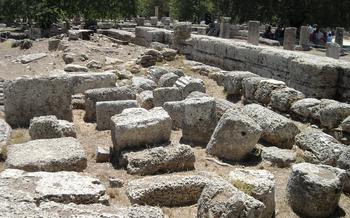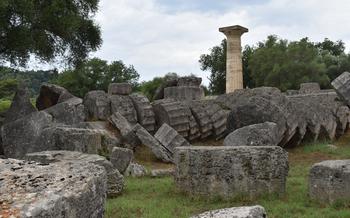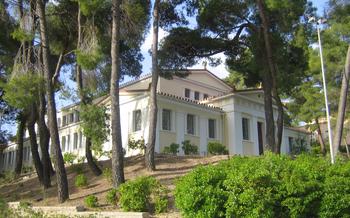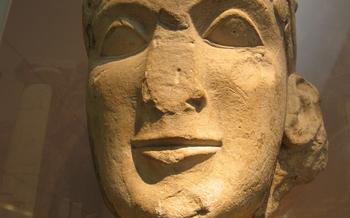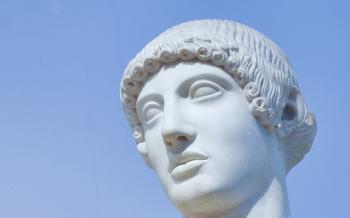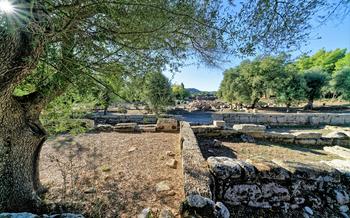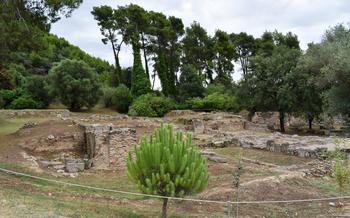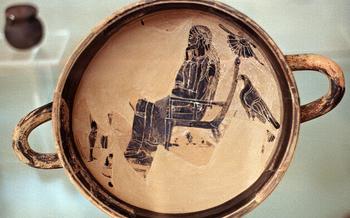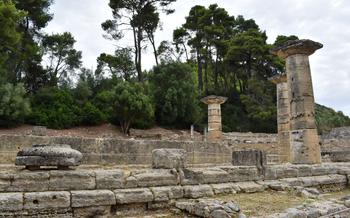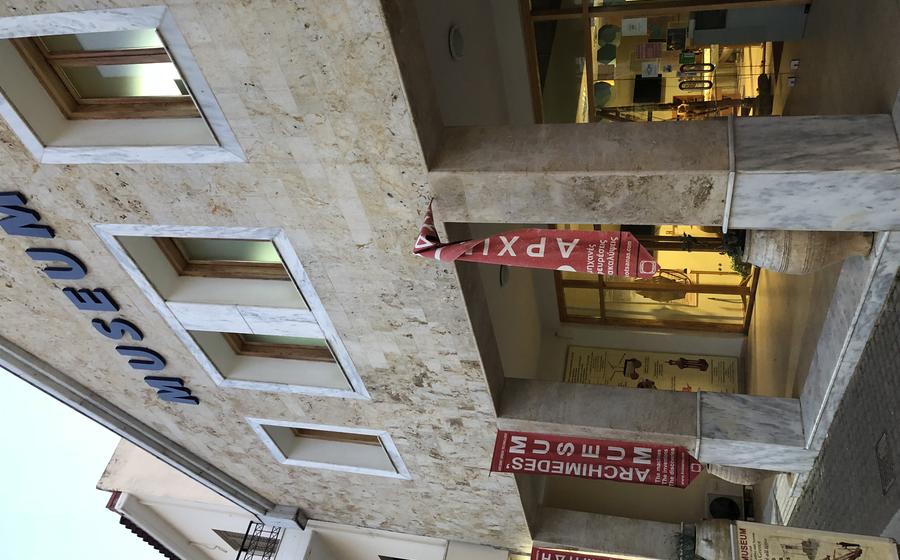
Archimedes' Museum
- A Journey Through Ancient Ingenuity
- Archimedes' Puzzle: A Mechanical Marvel
- Eureka! The Water Screw
- The Burning Mirrors of Syracuse
- The Archimedes Sphere: A Symphony of Celestial Motion
- Archimedes' Contributions to Mathematics
- Archimedes and Buoyancy
- Archimedes' Legacy in Engineering
- The Antikythera Mechanism: A Marvel of Ancient Computing
- The Archimedes Palimpsest: A Hidden Treasure Revealed
- Archimedes: The Man Behind the Genius
- Modern-Day Applications of Archimedes' Work
A Journey Through Ancient Ingenuity
Archimedes, the renowned ancient Greek mathematician, physicist, engineer, and astronomer, left an indelible mark on the world with his groundbreaking discoveries and inventions. Embark on a captivating journey through the Archimedes' Museum in Olympia, Greece, and delve into the depths of his brilliance. Explore interactive exhibits that bring Archimedes' inventions to life, showcasing the ingenious mechanisms and principles that defined his era. Discover the profound connections between his work and modern-day engineering, marveling at the enduring legacy of a mind that continues to inspire generations.
Archimedes' Puzzle: A Mechanical Marvel
Archimedes' Puzzle, also known as the Stomachion or Loculus Archimedius, is a captivating mechanical puzzle attributed to the ingenious mind of Archimedes. This intricate wooden puzzle consists of 14 uniquely shaped pieces that can be arranged in various combinations to form different shapes, including squares, rectangles, and triangles.
The puzzle's design and engineering principles are truly remarkable. Each piece is carefully crafted to interlock with the others, allowing for a wide range of configurations. The goal of the puzzle is to disassemble and then reassemble all 14 pieces into a single, solid square.
The exact origins and purpose of Archimedes' Puzzle remain shrouded in mystery. Some scholars believe it was a recreational pastime designed to challenge and entertain the minds of ancient Greek mathematicians and philosophers. Others suggest it held a deeper significance, perhaps as a teaching tool for geometry or as a representation of the universe's underlying order and harmony.
Today, Archimedes' Puzzle continues to fascinate and intrigue people of all ages. It is often used as a tool for teaching geometry and problem-solving skills, and it has inspired countless variations and adaptations over the centuries. Visitors to the Archimedes' Museum can engage in hands-on activities that allow them to build and solve their own Archimedes' Puzzle, experiencing firsthand the ingenuity and creativity of this ancient Greek master.
Eureka! The Water Screw
Archimedes' innovative genius extended beyond mathematics and physics to the realm of practical engineering. Among his most notable inventions was the water screw, a device that revolutionized water management and irrigation techniques.
The water screw, also known as the Archimedes screw, is a simple yet ingenious device consisting of a helical screw enclosed within a cylindrical tube. When the screw is rotated, it scoops up water from a lower level and transports it to a higher elevation. The rotation can be achieved manually or through the use of animal power or waterwheels.
The water screw offered several advantages over traditional water-lifting methods. It was more efficient, capable of raising large volumes of water with minimal effort. It was also more reliable, as it could operate continuously without requiring constant supervision. The water screw found widespread applications in ancient times, particularly in agriculture, where it was used to irrigate crops and drain flooded fields.
To witness the effectiveness of the water screw, visitors to the Archimedes' Museum can observe a working replica of the device in action. This interactive exhibit demonstrates how the water screw utilizes the principles of mechanics to effortlessly lift water from a lower reservoir to a higher one.
The Burning Mirrors of Syracuse
Archimedes' burning mirrors, a formidable weapon of ancient warfare, remain shrouded in mystery and intrigue to this day. While historical accounts vary, the underlying scientific principles behind these mirrors are fascinating.
Archimedes is said to have used an array of mirrors to focus and intensify sunlight, creating a powerful beam capable of setting enemy ships ablaze. The exact design and construction of these mirrors are unknown, but scholars believe they were likely made of polished metal or glass. By carefully positioning and aligning the mirrors, Archimedes could concentrate the sun's rays onto a single point, generating intense heat.
The effectiveness of Archimedes' burning mirrors has been debated for centuries. Some historians believe that the mirrors were capable of setting ships on fire, while others argue that their effectiveness was exaggerated. Regardless of their true capabilities, the burning mirrors represent a remarkable feat of ancient engineering and ingenuity.
At the Archimedes' Museum, visitors can engage in interactive experiments that illustrate the power of concentrated sunlight. These experiments demonstrate how mirrors can be used to focus and intensify light, creating a concentrated beam of energy. By manipulating mirrors and sunlight, visitors can gain a deeper understanding of the scientific principles behind Archimedes' legendary burning mirrors.
The Archimedes Sphere: A Symphony of Celestial Motion
At the Archimedes' Museum in Olympia, visitors can marvel at the intricate Archimedes Sphere, a mechanical marvel that showcases the ancient Greek's mastery of engineering and astronomy. This remarkable invention, crafted by Archimedes in the 3rd century BC, represents the celestial sphere and the harmonious movement of the planets.
The Archimedes Sphere is a hollow sphere with a series of concentric rings, each representing a different planet. The rings are connected by a system of gears, allowing them to rotate independently. By rotating the sphere, visitors can observe the relative motions of the planets and the stars, simulating the cosmos in miniature.
The sphere's intricate design and craftsmanship are a testament to Archimedes' brilliance as an engineer and mathematician. The precise calculations and measurements required to create the sphere demonstrate his deep understanding of planetary motion and the celestial sphere.
Visitors to the museum can manipulate a replica of the Archimedes Sphere, allowing them to witness firsthand the harmonious movement of the planets. This interactive experience provides a deeper appreciation for the ingenuity and scientific prowess of Archimedes, whose work continues to inspire and fascinate generations.
Archimedes' Contributions to Mathematics
Through his profound mathematical insights, Archimedes left an indelible mark on the history of mathematics, contributing to the development of geometry, calculus, and mensuration. Among his most notable achievements is the method of exhaustion, a precursor to modern calculus that enabled him to calculate the area of irregular shapes by dividing them into an infinite number of smaller shapes. This groundbreaking approach laid the foundation for the development of integral calculus centuries later.
Archimedes also made significant contributions to the measurement of the circle, calculating the value of pi with remarkable accuracy. Using inscribed and circumscribed regular polygons, he determined that the ratio of a circle's circumference to its diameter is approximately 14, establishing a fundamental constant in mathematics.
Furthermore, Archimedes explored the concept of floating bodies and the principles of buoyancy, which led to his famous "Eureka!" moment. His work on buoyancy, known as Archimedes' principle, laid the foundation for understanding fluid mechanics and has practical applications in various fields, including ship design and fluid dynamics.
Archimedes' mathematical prowess extended beyond geometry and calculus, as he also conducted groundbreaking research in number theory, mechanics, and astronomy. His enduring legacy in mathematics continues to inspire and inform modern-day mathematicians and scientists, demonstrating the far-reaching impact of his intellectual pursuits.
Archimedes and Buoyancy
Through his meticulous experimentation and keen observation, Archimedes formulated one of the most fundamental principles of physics – the principle of buoyancy. The story of his "Eureka!" moment is well-known: while immersed in a bath, he noticed that the water level rose, leading him to the realization that an object displaces an equal volume of fluid when submerged.
This principle, known as Archimedes' principle, elucidates the relationship between an object's buoyancy and its density relative to the surrounding fluid. It states that the upward buoyant force acting on an object is equal to the weight of the fluid displaced by the object. This principle has far-reaching implications in various fields, including ship design, fluid mechanics, and hydrometry.
In the Archimedes' Museum, visitors can delve deeper into the intricacies of buoyancy through interactive exhibits and hands-on experiments. They can witness firsthand how objects of different densities float, sink, or remain suspended in fluids. These activities provide a tangible understanding of the principles governing the behavior of objects in fluids.
Archimedes' principle has found practical applications in diverse industries. It is essential in determining the buoyancy of ships and submarines, ensuring their stability and safe operation. In fluid mechanics, it helps engineers design pumps, turbines, and other devices that harness the power of fluids. Additionally, Archimedes' principle is used in hydrometry to measure the density and specific gravity of fluids, which is crucial in various scientific and industrial applications.
By unraveling the mysteries of buoyancy, Archimedes laid the foundation for our understanding of fluid mechanics and its practical applications. His work continues to inspire and inform engineers, scientists, and inventors to this day, demonstrating the enduring legacy of his scientific genius.
Archimedes' Legacy in Engineering
Through the annals of history, Archimedes' engineering marvels have left an enduring mark on the landscape of modern-day engineering practices. His groundbreaking inventions and principles have served as cornerstones for the development of diverse fields, including mechanics, hydraulics, and optics.
In the realm of mechanics, Archimedes' contributions to the understanding of levers, pulleys, and gears have laid the foundation for modern-day machines and mechanisms. His work on buoyancy and fluid mechanics continues to guide the design of ships, submarines, and other watercraft.
Archimedes' influence is also evident in the field of hydraulics, where his water screw remains an indispensable tool for lifting water and other fluids. This simple yet effective device has found applications in irrigation, water supply systems, and even Archimedes's water screw.
Moreover, Archimedes' exploration of optics and the use of mirrors has paved the way for the development of modern-day optical instruments, including telescopes, microscopes, and lasers. His theories on the reflection and refraction of light have been instrumental in the advancement of optics and imaging technologies.
To fully appreciate the enduring impact of Archimedes' legacy, visitors to the Archimedes' Museum can engage in interactive engineering challenges that showcase the practical relevance of his ideas. These hands-on activities allow visitors to experience firsthand the ingenuity and creativity that characterized Archimedes' work and its lasting influence on modern-day engineering.
The Antikythera Mechanism: A Marvel of Ancient Computing
Discover the remarkable Antikythera Mechanism, an ancient analog computer attributed to Archimedes' influence. This intricate mechanical marvel, crafted around 100 BC, is considered one of the most sophisticated inventions of the ancient world.
Delve into the workings of this astronomical calculator, capable of predicting the positions of the sun, moon, and planets, as well as eclipsing cycles. Explore its intricate gears, dials, and pointers, which allowed ancient astronomers to track celestial events with unprecedented accuracy.
Uncover the historical significance of the Antikythera Mechanism as a testament to ancient Greek ingenuity. Imagine the awe and wonder it must have inspired in those who first witnessed its computational prowess.
Manipulate a replica of the Antikythera Mechanism to witness its remarkable capabilities firsthand. Engage with this ancient marvel and marvel at the ingenuity of its creators, who laid the foundation for modern computing centuries before their time.
The Archimedes Palimpsest: A Hidden Treasure Revealed
Amidst the annals of scientific history lies a remarkable tale of rediscovery—the story of the Archimedes Palimpsest. This medieval manuscript, crafted in the 13th century, holds a precious secret: hidden beneath layers of religious text lie the lost works of Archimedes, obscured for centuries.
In the early 1900s, Danish scholar Johan Ludvig Heiberg embarked on a painstaking journey to decipher the palimpsest's faded script. Through a meticulous process of chemical treatment and ultraviolet photography, he painstakingly revealed the hidden mathematical treasures beneath.
The Archimedes Palimpsest contains treatises on a wide range of topics, including buoyancy, the measurement of the circle, and the calculation of pi. It offers invaluable insights into Archimedes' groundbreaking work and provides a glimpse into the mind of one of history's greatest thinkers.
Visiting the Archimedes' Museum in Olympia offers a unique opportunity to delve into the story of the palimpsest. Here, visitors can examine facsimiles of its pages, marveling at the intricate diagrams and calculations that lay hidden for centuries.
The Archimedes Palimpsest stands as a testament to the enduring power of Archimedes' legacy. It is a reminder that even in the face of time and obscurity, the brilliance of human intellect can endure.
Archimedes: The Man Behind the Genius
Archimedes, the renowned ancient Greek scientist, mathematician, and engineer, was not merely a brilliant mind but also a fascinating and enigmatic figure. Beyond his groundbreaking scientific achievements, Archimedes' personal life and eccentricities have captured the imagination of generations.
Historical anecdotes and stories provide glimpses into Archimedes' unique personality and unwavering dedication to his work. He was known for his absent-mindedness and preoccupation with his studies, often forgetting to eat or care for his appearance. Archimedes' relentless pursuit of knowledge led him to exclaim "Eureka!" (meaning "I have found it!") while stepping into a bath, supposedly experiencing a breakthrough in understanding buoyancy.
Archimedes lived in a vibrant cultural and intellectual context in the ancient Greek city of Syracuse. He was part of a thriving community of scholars and thinkers who engaged in lively debates and discussions. Archimedes' work was greatly influenced by the Pythagorean philosophy, which emphasized the importance of mathematics and reason in understanding the natural world.
Despite his extraordinary achievements, Archimedes remained humble and dedicated to his craft. He was known for his generosity in sharing his knowledge with others, mentoring younger scholars, and contributing to the advancement of science and engineering. Archimedes' enduring fascination lies in his embodiment of human ingenuity, creativity, and the pursuit of knowledge, inspiring generations to come.
Modern-Day Applications of Archimedes' Work
Archimedes' legacy extends far beyond the ancient world, as his ideas and inventions continue to inspire and inform modern technology and engineering. His principles of mechanics, buoyancy, and geometry have found practical applications in a wide range of fields, from robotics to computer science and renewable energy.
In robotics, Archimedes' work on levers and pulleys has been instrumental in the development of robotic arms and other articulated mechanisms. His insights into the mechanics of lifting and moving objects have also influenced the design of industrial robots and automated machinery.
In computer science, Archimedes' method of exhaustion, a precursor to modern calculus, has laid the groundwork for the development of algorithms and numerical methods used in computer graphics, simulations, and data analysis. His work on the measurement of the circle and the calculation of pi has also been essential in the development of computer-aided design (CAD) and other geometric modeling software.
In the field of renewable energy, Archimedes' screw, a device for lifting water, has been adapted to generate electricity from flowing water. Modern Archimedes screws are used in hydroelectric power plants to convert the energy of moving water into electricity, providing a clean and sustainable source of energy.
These are just a few examples of the many ways in which Archimedes' work continues to shape the modern world. His legacy as a brilliant engineer and mathematician is evident in the countless technologies and innovations that we rely on today.
